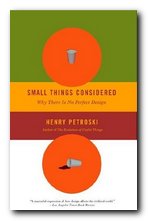reasons why there is no perfect design
Henry Petrowski is professor of civil engineering and history at Duke University, North Carolina. He writes extensively on engineering and design in a populist manner which helps to explain academic and scientific matters to the average reader. And he does it very well. He has a fluent and easy style which reads like someone talking to you over drinks on a veranda on a hot sunny afternoon. Small Things Considered is a good example of his work.
 His main argument in this, one of his many books on the subject, is that considerations of design affect even the small matters of everyday life. And I mean small. Nothing is too insignificant in the running of a normal house to escape his attention – thirty pages on a glass of water, a whole chapter on coffee cup holders in cars, or on the design of paper bags. There’s even a chapter on the positioning of handles on doors.
His main argument in this, one of his many books on the subject, is that considerations of design affect even the small matters of everyday life. And I mean small. Nothing is too insignificant in the running of a normal house to escape his attention – thirty pages on a glass of water, a whole chapter on coffee cup holders in cars, or on the design of paper bags. There’s even a chapter on the positioning of handles on doors.
The reason this is all spelled out at such length is that as part of his leisurely style, he looks at all the ways the design of something might have gone wrong, how the designers could have failed or overlooked some important requirement – before he goes on to look at the more essential element of how they got it right. Nevertheless, his sub-title is significant: even the best-designed objects can eventually be improved upon. As he points out, most patent applications carry ‘Improvement on …’ as part of their title.
The best parts of his accounts are where he delivers the history of a design or an invention, the practicalities of making something work and the financing of prototypes and commercial models. He’s also good the moment he strays into issues of patents, copyright, and ownership, because he obviously knows the history of his subject.
He waxes eloquently about very basic products such as duct tape, WD-40, and Teflon, pointing out just how much research and design went into these apparently simple items. Indeed, WD-40 even gets its name from the fact that the manufacturer’s previous thirty-nine attempts to develop a Water Displacement prototype had not been successful. It was the fortieth that delivered the goods – and then more so when people found all sorts of inventive uses for it. Now it is used for oiling squeaky hinges, loosening stubborn bolts, dissolving glue, and even killing insects.
The most successful chapters are those that consider the details of a specific and complex product. Office chairs are a good case in point. His account of how the Herman Miller Aeron displaced the Steelcase chair of the 1950s takes into account ergonomics, materials, design innovation, ecology, and even social attitudes, though curiously enough he doesn’t mention economics (the Aeron is formidably expensive – as I discovered when I tried to buy one recently).
This is a book to be read alongside Donald Norman’s The Design of Everyday Things and Victor Papanek’s Design for the Real World. It certainly warrants a place on the syllabus of any serious design course, though I doubt that it will reach the classic status of those other two texts, even though it attempts to do so.
© Roy Johnson 2009
Henry Petrowski, Small Things Considered, New York: Vintage Books, 2003, pp.288, ISBN: 1400032938
More on design
More on media
More on web design
More on information design